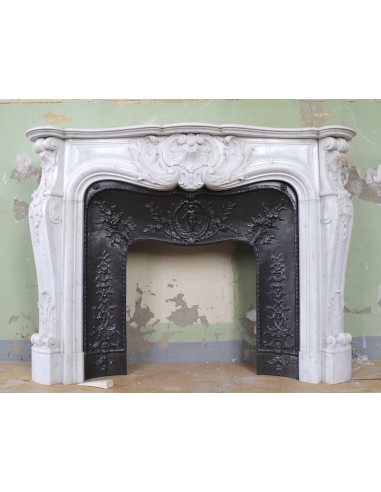THIS FIREPLACE, BEYOND ITS VERY HIGH SCULPTURAL QUALITY (UNDOUBTEDLY THE WORK OF A MASTER FROM PIETRASANTA AND/OR AT ANY RATE FROM LUNIGIANA) HAS ANOTHER AND IMPORTANT CHARACTERISTIC:
EVERY PART OF IT HAS BEEN DESIGNED AND SCULPTED WITHOUT ANY PARSIMONY, IN EVERY WHERE NOTHING HAS BEEN MADE LACKING IN THIS “ROSACES” FIREPLACE, LET US EXAMINE TOGETHER, IF YOU LIKE, EVERY PART OF IT:
THE FRIEZE.
In the center of the frieze, from above descends a shell stylized in a leafy and floral manner. Said shell, in fact, arises (let us start from the top) from a nucleus that is represented by a daisy (dutiful homage to Louis XIV, the Sun King) and departs in stylized leaf-shaped valves, leaves, moreover, also kissed. The whole is “embraced” in a kind of oval by two “rocaille” profiles (these are parts of the section of the most sculpted shell in the world, the very famous “Nautilus.” These two rocaille “embraces,” we also find them immediately below the larger shell, serving as pages to two bellflowers hanging from the sculpture (the upper shell) we have discussed so far..
Outside this central sculpture, branching off from two curls placed at the base of the frontal, we have a riot of leaves, some of which spread out toward the lower exterior of the frontal, some of which (the larger ones) instead rise up to further frame the central sculpture of the frontal itself.
THE SIDES
Normally the marble slabs on the sides of the fireplace have a smooth surface... In some cases (we are talking about fireplaces with great decorative load) a groove in the marble draws a box on the sides themselves, a kind of frame to soften a normally “abandoned” slab, as if the fireplace should be visually enjoyed only by looking at it in front and not at the sides..
In this case, on the other hand, we have a complex design (with central “ronde”) and carved not through a simple marble “groove” but with refined grooves and counter grooves, characteristic of an ever-present and attentive sculptural quality.
THE LEGS.
Well, here, in the legs of this fantastic sculptural work, the architect who designed it and the sculptor who brought it to light have reached truly high levels.
Again, I start from the top to describe the Beauties of this “leg.”
Immediately below the platform we see a classic curl.
“What can it be, you may ask, to us it looks like a simple curl, equal to many others.”
No, you are wrong, nothing here is equal to anything else, take a little trip to view curls (in the Louis XV section of our site you can make comparisons galore) and you will realize its, happy and solid, diversity.
Underneath the curl, the first surprise: The “shell” below is, SHOWN IN REDUCED SCALE, the same shell placed in the center of the frontal, also made up of podded leaves arising from the corolla of a daisy. Detail this, definable more than “original,” entirely “unique in the world.”
Underneath this “shell,” a small campanula connects with a series of leafy elements that act as a connecting stretch between the capital and the “thigh” of the leg, architectural elements usually joined together by a marble “torello,” in this case beautifully submerged by quite another and artistic “connection.”
Fascinating and original, too, is the “shoehorn” of the foot, which sees the emergence, from another curl of original form, of a cartouche of great strength
ITS CAST IRON INSERT
Even what should normally be an accessory, and therefore an item perhaps pretty but not “dominant” from an aesthetic point of view, well, this accessory also has a UNIQUE prerogative, which I challenge you to find, that in my opinion no one has ever seen or owned: In its upper part, one on the right and one on the left, you will see two “rosettes” (I remind you that the name of this fireplace is “Rosaces,” which means “Rosettes” in French), but not just any two rosettes, but two rosettes that spin on themselves (like the pinwheels we used to tie to the handlebars of our bicycles as children for the pleasure of seeing them “whizzing”), particular roses that for the French represent the tip of the Christmas Comet, which, in this double appearance represents the hosts, in all likelihood the head of the family and his wife, parents who act as light and guide for their children.
The cast iron insert is beautiful, with that winged putto (a classic and always pleasing cupid) and that leafy, floral affixing, as well as highly original (you will not see one like it (but neither will you see one simply similar) in the 200 cast iron inserts in our warehouse).
LO AND BEHOLD, IT IS FOR THE REASONS I HAVE DESCRIBED ABOVE THAT I CONSIDER THIS EXAMPLE OF A FIREPLACE FROM THE “ROSACES” FAMILY TO BE UNIQUE.
PARISIAN FIND, SCULPTURE PERIOD 1850-60, PERFECT PRESERVATION.
027 AG ANTIQUE LOUIS XV "ROSACES" FIREPLACE MANTEL CARVED IN WHITE CARRARA MARBLE WITH ITS OWN ORIGINAL FLORAL CAST IRON INSERT
Louis XV
€18,500.00
No tax
SHARE ON:
Description
Reviews (0)
No reviews

































































































